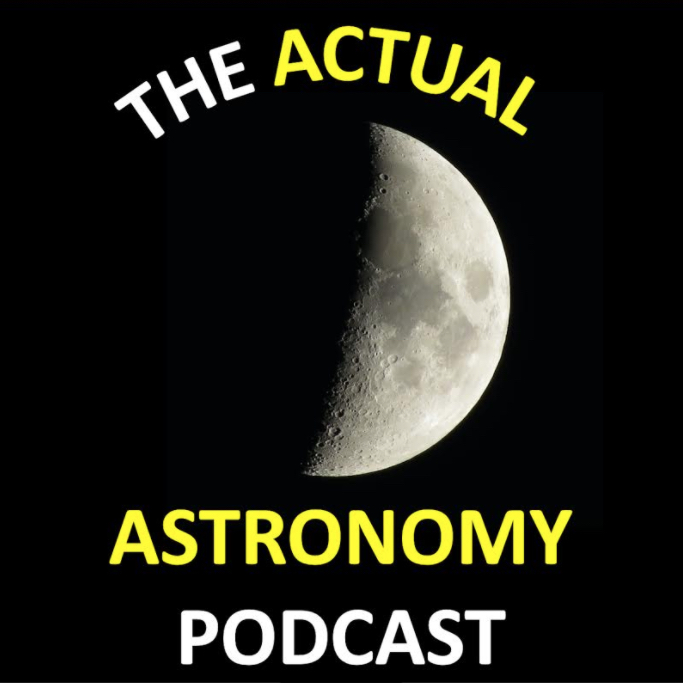Podcaster: Shane and Chris

Title: Objects to Observe in the February 2023 Night Sky
Organization: Actual Astronomy
Link : https://actualastronomy.podbean.com/
Description: The Actual Astronomy Podcast presents Objects to Observe in the February 2023 Night Sky. In this episode we’ll talk about a conjunction of Venus and Neptune, the Moon pairing up with Venus & Jupiter before it gets so close to Mars. We’ll also talk about Comets and the Constellation Orion.
Bio: Shane and Chris are amateur astronomers who enjoy teaching astronomy classes and performing outreach where they help the eyes of the public to telescope eyepieces.
Today’s sponsor: Big thanks to our Patreon supporters this month: Rob Leeson, David Bowes, Brett Duane, Benett Bolek, Mary Ann, Frank Frankovic, Michael Freedman, Kim Hay, Steven Emert, Frank Tippin, Rani Bush, Jako Danar, Joseph J. Biernat, Nik Whitehead, Michael W, Cherry Wood, Steve Nerlich, Steven Kluth, James K Wood, Katrina Ince, Phyllis Foster, Don Swartwout, Barbara Geier, Steven Jansen, Donald Immerwahr
Please consider sponsoring a day or two. Just click on the “Donate” button on the lower left side of this webpage, or contact us at signup@365daysofastronomy.org.
Please visit our Patreon page: https://www.patreon.com/365DaysOfAstronomy
or you can consider to sponsor a day of our podcast : https://cosmoquest.org/x/365daysofastronomy/product/sponsor-an-episode-of-365-days-of-astronomy/
Transcript:
The Objects to Observe in the February 2023 Night Sky on Episode 297 of the Actual Astronomy Podcast. I’m Chris and joining me is Shane, we are amateur astronomers who love looking up at the night sky and today we are asking what’s up with this weather.
Did you get any observing in this week Shane?
In this episode we’ll talk about the Zodiacal light, Venus and Neptune in the same field of view, the Moon pairing up with Venus & Jupiter then the Moon before it gets so close to Mars in your telescope. Oh and just to let those listening on the 365 Days of Astronomy you can catch all 8 Actual Astronomy Podcasts by subscribing in Apple Podcasts, Spotify or any podcatching app. Show notes for this episode will be available on our website www.actualastronomy.com
- February 3rd – Castor, Pollux and Moon line up

- Full Moon February 5th
- Zodiacal light is visible in the Western sky once the Moon is out of the way near mid-month.
- What is the Zodiacal light?
- What does it Look like?
- How can one see it.
- February 13 – Last quarter Moon
- February 15th – Venus and Neptune in conjunction and the same telescopic field!
- Now you will need a telescope to see it.

-February 20th – new Moon
– February 21st, evening sky – Moon, Venus and Jupiter


- Feb 22 Jupiter & Moon in same low power eyepiece & Occultation in S. S America
- Feb. 26 – Pleiades / Moon & Hyades


- Feb 27 – First quarter Moon
- Feb 27th – Mars & the Moon very close – look for the phase.
- Feb 28th – Lunar Straight wall visible this evening

Comets!
- Comet ZTF E3 will be slowly fading but the Moon interferes until the end of the month when it may be 8th magnitude.
- However, Comet K2 Panstarrs might be 6th magnitude…but you’ll have to head south!
Orion is our shallow dive this month.
- Orion passes through the median in the early evening hours
- Oldest depiction of Orion’s hourglass figure is an ivory carving found in Germany and it is as old as 38,000 years ago.
- Known to the babylonians as the Heavenly Sheppard
- In Greek mythology Orion was a supernatural hunter, and boastful to, so dispatched by a Scorpion sent to kill him…both would be placed in the sky but opposite one another so they wouldn’t quarrel.
- Orion is the central winter constellation whose stars guide us around the entire sky this time of year.
- To those of us who observe Orion it is home to Messier 42, the Great Orion Nebula. A star forming Region almost 2000 light years away but visible to the unaided eye as a fuzzy spot in the sword of Orion.
- How do we find the sword?
- What does M42 look like in binoculars…vertical star clusters with a fuzzy one. That’s M42.

- Double star in Orion – Rigel bottom right foot.
Outro:
Did you enjoy this podcast? We would appreciate it if you could do us a favour and leave a 5 star rating and say something fun and positive about the show and you will help other observers find The Actual Astronomy Podcast in 2023.
End of podcast:
365 Days of Astronomy
=====================
The 365 Days of Astronomy Podcast is produced by Planetary Science Institute. Audio post-production by Richard Drumm. Bandwidth donated by libsyn.com and wizzard media. You may reproduce and distribute this audio for non-commercial purposes.
This show is made possible thanks to the generous donations of people like you! Please consider supporting to our show on Patreon.com/365DaysofAstronomy and get access to bonus content.
After 10 years, the 365 Days of Astronomy podcast is poised to enter its second decade of sharing important milestone in space

